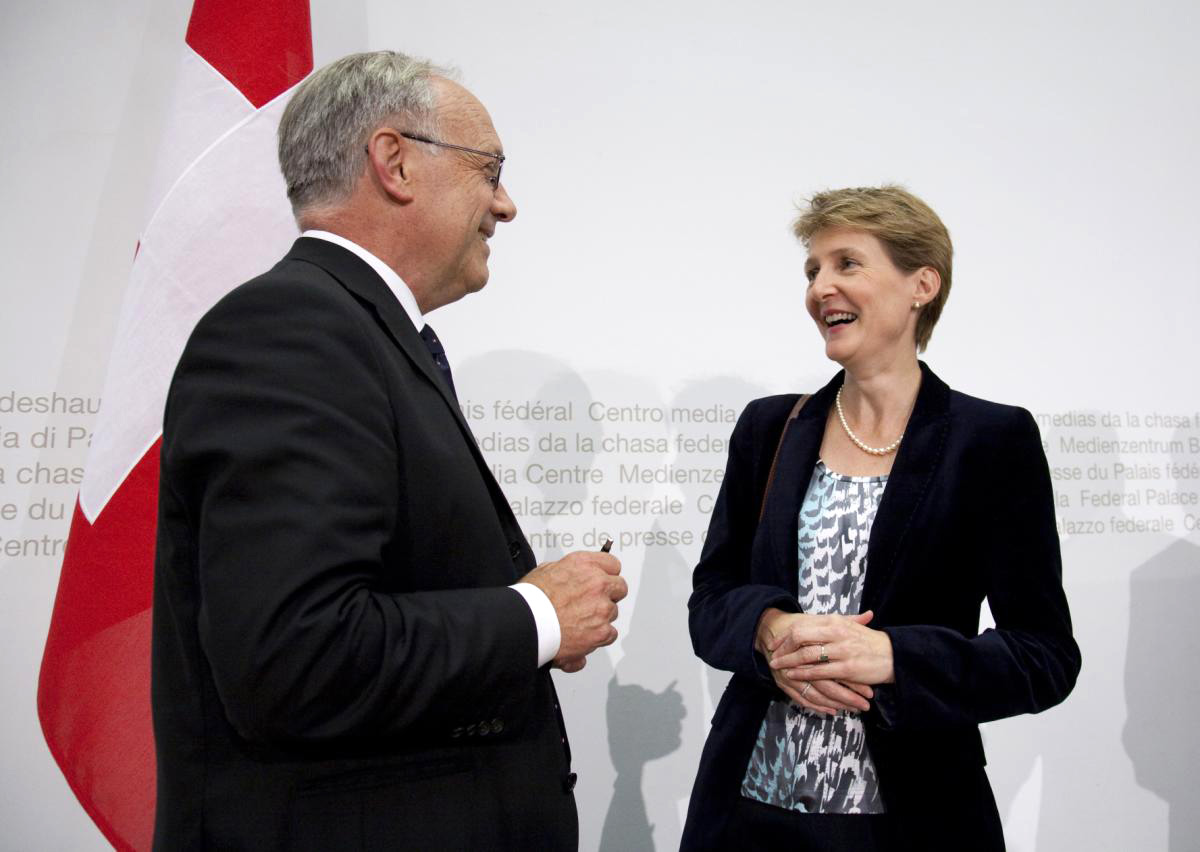
Historic vote seen as cause for pride

The mood across the Swiss media after Wednesday’s elections is one of pride and hope that the first female-majority government can restore harmony.
But newspaper commentators cautioned that despite the historic power arrangement, the tasks that face the seven-member cabinet are “gigantic” and that there is little time for finding solutions.
Centre-left Social Democrat Simonetta Sommaruga and Johann Schneider-Ammann of the centre-right Radical Party became the two new faces in government replacing outgoing ministers Moritz Leuenberger and Hans-Rudolf Merz, respectively.
The election means Switzerland’s executive branch now has a four-to-three female majority for the first time in the constitution’s 162-year history.
“A country historically hesitant over the equality of the sexes now has a strong message: Competence rules, without discrimination,” said Le Temps in an opinion piece called, A return to reliable values.
“The idea of a government more united and credible in the eyes of the population became possible when the candidates carried that promise. It’s a remarkable fact that gender played no decisive role in this election.”
In a humorous twist, the paper ran a front page cartoon of the four women ministers asking the three men to go and fetch coffee, a reverse play on a previous cartoon when the last male minister was elected.
But the newspaper joined a serious chorus of others in saying that only time will tell whether this new government can truly restore a sense of harmony after so many ministers performing as “solo dancers”, as the Zurich-based Tages-Anzeiger put it.
Many agreed that the rightwing Swiss People’s Party, whose candidate enjoyed strong cross-party support, is well on its way to gaining another cabinet seat—perhaps the last hurdle to restoring peace.
A quality duo
The country is off to a good start, many commentators agreed. The Tribune de Genève said that Sommaruga and Schneider-Ammann represent a “quality duo” who will promote stability and collegiality in the government. They must not fail, it said.
“They have a year to show it can be [done],” the paper argued under a banner headline, She broke down a wall.
“If not, it’s not the people we need to change, but the system. It’s not certain that this historic arrangement can weather the coming storm.”
The cabinet will be meeting on Monday to divide up the work as each member is responsible for overseeing various ministries. A reshuffle of duties hasn’t been ruled out.
“The issue of the division of labour is enormous,” said the Tages-Anzeiger.
“The financial place needs new footing, social insurance a long-term rescue plan, the railway billions. On top of that, Switzerland needs to redefine its relationship with the European Union. Stable relations are more important than ever.”
The paper’s cross-town rival, the Neue Zürcher Zeitung (NZZ), said hopes are high that the two new ministers—“Madame Perfect” and “Mister Workplace”—will handle the task with aplomb.
Blick voiced some caution: “That remains to be seen,” the newspaper said. After they divide up the work, “that will show whether the new government can work together as well as the two new ones hope.”
Rightwing rise
Nearly every paper dedicated some ink to those who did not get elected yesterday.
Le Temps said one of the election’s disappointments was that another woman—presumably Radical Party member Karin Keller-Sutter—was not placed in the government. “The Greens and the dogmatic left, through their clumsiness and lack of agreement denied Switzerland a fifth,” it lamented.
Others noted that People’s Party candidate Jean-François Rime, who mustered as many as 93 votes out of 123 needed, could represent a shift in the rightwing party allowing its members “to sometimes reach across party lines”, Blick said in a piece entitled, He lost but he’s still a winner.
“In Rime, many people see the revival of the good old People’s Party,” it said. The Tages-Anzeiger agreed, saying the fate of the party remains in its own hands. It must reach out and build goodwill, however, if “the system of powering sharing is to be repaired”.
In the end though, no commentators were imprudent enough to argue that the glow from the “symbolic,” “spectacular”, and “historic” election would survive for long without real results.
“The peace of yesterday is fragile and provisional,” Le Temps said. “Yesterday’s calm does not in any way guarantee tomorrow’s wisdom.”
The Swiss government consists of a cabinet made up of seven members.
There is no prime minister. The position of president rotates among cabinet ministers every year.
The cabinet should reflect the political, cultural and linguistic diversity of the country.
For 50 years cabinet posts were shared out among the four main parties – the Radicals, the Christian Democrats, the Social Democrats and the Swiss People’s Party – under an informal agreement.
The system known as the Magic Formula was thrown out in 2003.
A fundamental tenet of the multiparty cabinet is the need to reach consensus and that decisions are taken collectively.
Cabinet members are nominated by their parties, and are elected at a joint session of the two chambers of parliament.
The ballot is secret.
A candidate needs at least 50% plus one vote of valid ballot sheets to be elected.
The seven cabinet members have to be confirmed in their posts every four years in the wake of parliamentary elections due in October 2011.

In compliance with the JTI standards
More: SWI swissinfo.ch certified by the Journalism Trust Initiative




























You can find an overview of ongoing debates with our journalists here . Please join us!
If you want to start a conversation about a topic raised in this article or want to report factual errors, email us at english@swissinfo.ch.